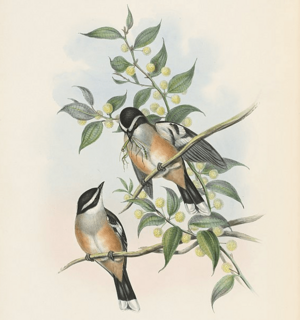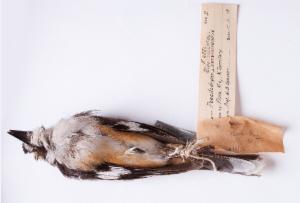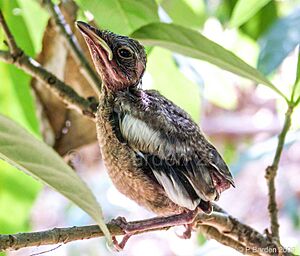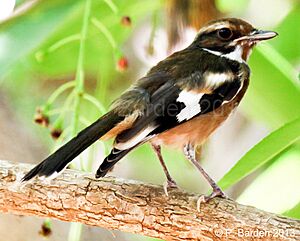Buff-sided robin facts for kids
Quick facts for kids Buff-sided robin |
|
|---|---|
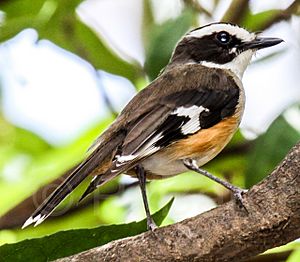 |
|
| in the Northern Territory | |
| Conservation status | |
| Scientific classification | |
| Genus: |
Poecilodryas
|
| Species: |
cerviniventris
|
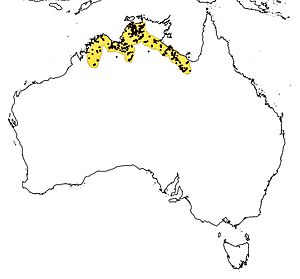 |
|
| Poecilodryas cerviniventris range | |
| Synonyms | |
|
|
The buff-sided robin (Poecilodryas cerviniventris) is a small bird found only in northern Australia. It is a type of passerine bird, which means it can perch on branches. This robin is part of the Petroicidae family, also known as Australasian robins.
This bird eats mostly insects. It is active during the day. You might also hear it called the buff-sided fly-robin or buff-sided shrike-robin. It lives mainly in forests near rivers and in dense monsoon vine thickets. Its home stretches from the Kimberley region in Western Australia to the Gulf of Carpentaria in Queensland.
Adult buff-sided robins have a dark head and back. They have a clear white stripe above their eye. Their throat is white, and they have white markings on their wings and tail. A bright buff or orange patch is on their sides, just under their wings. Males and females look similar, but males are usually a bit bigger.
Buff-sided robins mostly catch insects from the ground. They watch from a perch, then fly down to grab their prey. Sometimes, they catch flying insects in the air. They also pick insects off tree trunks or leaves.
Contents
How Was the Buff-sided Robin Discovered?
The buff-sided robin was first described in 1857 by a scientist named John Gould. He based his description on birds collected by Joseph Ravenscroft Elsey in 1856. Elsey was a naturalist and surgeon. He stayed near the Victoria River in the Northern Territory. This was during an expedition led by Augustus Charles Gregory.
Elsey collected many new species there, including the buff-sided robin. He wrote to Gould in June 1856 about his observations. Elsey described the robin's appearance and its "pretty little piping note." He also found its nest, which was shallow and held two eggs. The eggs were greenish-grey with brown speckles.
Gould praised Elsey's work. He said Elsey's long stay at the Victoria River helped discover this new bird. After this, other naturalists collected buff-sided robins. They found them in different parts of northern Australia. These collectors included T. H. Bowyer-Bower, A.J. North, J.P. Rogers, and F. L. Whitlock. In the Northern Territory, Walter Baldwin Spencer and H.G. Barnard also collected specimens. The first birds from Queensland were collected by W. McLennan in 1909.
How Scientists Classify the Buff-sided Robin
When first described, the buff-sided robin was named Petroica cerviniventris. This was by John Gould in 1857. But Gould thought it might need its own group. Later, it was placed in the genus Poecilodryas. This group includes seven species from Australia, New Guinea, and nearby islands.
Gould noticed that the buff-sided robin looked similar to the white-browed robin (Poecilodryas superciliosa). This other robin was found in Queensland in 1845. For many years, some scientists thought they were the same species.
However, later studies showed they are different. Scientists compared their size, colors, and markings. They found clear differences, like the buff-sided robin being larger. It also has richer colors on its sides and different white markings on its tail.
Genetic tests also showed they are separate species. They are closely related, but they have enough differences in their DNA. This suggests they became different species over time. This happened because they were separated by geography, like the Gulf of Carpentaria.
The name Poecilodryas comes from ancient Greek. It means 'spotted or dappled wood-nymph'. This refers to the spots on the wings and tail of birds in this group. The name cerviniventris comes from Latin. It means 'stag-bellied', referring to the buff color on the bird's chest.
What Does the Buff-sided Robin Look Like?
The buff-sided robin is a medium to large robin. It is about 16 to 18 centimeters (6 to 7 inches) long. Males and females have similar feather colors. So, you can't tell them apart just by looking at their plumage. However, males are generally bigger than females. They are heavier and have longer heads, bills, and wings.
Adult male buff-sided robins weigh about 20 to 25.5 grams (0.7 to 0.9 ounces). Females weigh about 15.5 to 20.3 grams (0.5 to 0.7 ounces).
Adult Plumage
Adult birds have a dark head and neck. They have a clear white stripe above their eye. The area around their eyes is black, and their cheeks are white. Their throat is also white. The back of their neck and upper back are dark olive-brown to black. Their chest has a grey wash. The sides of their body are a deep fawn color, becoming almost white on their belly.
Their wings are dark brown to black. The tips of some wing feathers and tail feathers are white. The bill is black, and the legs and feet are grey to blackish-brown. Their eyes are dark brown.
You can tell them apart from the similar white-browed robin. Buff-sided robins are larger. They have a thicker white stripe above the eye. Their upper back is darker, and they have a broad black face band. Their chest is greyer, and they have more white on their wing and tail feathers.
Young Birds' Plumage
Young buff-sided robins (juveniles) have rusty brown heads, necks, and upper bodies. They have faint cream-colored stripes. Their back is dark brown. Their wing feathers have white tips with buff ends. They also have white tips on their tail feathers, similar to adults but paler.
As they get older (first immature plumage), they start to look more like adults. But they still have dark buff colors on their throat, forehead, and crown. Their chest is a mix of grey and rusty brown. Their sides and belly are light buff. White feathers begin to appear above their eyes and on their cheeks.
Where Do Buff-sided Robins Live?
The buff-sided robin lives in suitable areas along the northern coast of Australia. This includes the Kimberley region in Western Australia. It also lives in the Top End of the Northern Territory. Its range extends to the north-western Gulf of Carpentaria in Queensland.
In Western Australia, you can find them in national parks like Geikie Gorge. In the Northern Territory, they are in places like Keep River National Park and Kakadu National Park. In Queensland, they live in Boodjamulla (Lawn Hill) National Park.
These birds mostly live in dense forests near rivers. They also like subcoastal and sandstone monsoon vine-thickets. In river areas, they prefer thick groups of freshwater mangroves, pandanus, and bamboo. Their main habitat has tall trees like Melaleuca leucadendra and Nauclea orientalis. They rarely go into drier, more open forests nearby. Sometimes, they are seen in mangrove areas near the coast.
Early observers noted their habitat preferences. Elsey said they lived in "mangroves" near the Victoria River. Whitlock confirmed this, saying they were "almost exclusively confined" to river forests. Hill described them in "thick scrub and timber... near water" on the McArthur River. These observations show how much they rely on these dense, wet habitats.
How Do Buff-sided Robins Behave?
What Do They Eat and How Do They Hunt?
The buff-sided robin is an insectivore, meaning it eats insects. It hunts during the day. It mostly hunts by watching from a perch. Then, it flies down to a hard surface, usually the ground, to catch its prey. This method is called "sallying."
One study found that 95% of their successful hunts were sally strikes onto a surface. About 5% were "hawking," which means catching a flying insect in the air. They also sometimes pick insects off tree trunks, branches, or leaves. Most of their hunting happens close to the ground, usually within 3 meters (10 feet).
Scientists haven't studied their diet in great detail. But we know they eat various insects. These include beetles, ants, and moth and butterfly larvae. They also eat spiders and other small creatures.
How Do They Reproduce?
Buff-sided robins breed throughout their range. Most breeding happens during the warmer, wet season, from October to March. Sometimes, they nest during the dry season too. They usually lay two eggs. The eggs are about 17.8 to 20.3 millimeters (0.7 to 0.8 inches) long.
Egg colors vary a lot. They can be light green to dark olive-green. They often have reddish-brown or purplish-buff markings. We don't know how long it takes for young birds to fledge (leave the nest).
Sometimes, other birds lay their eggs in a buff-sided robin's nest. This is called "brood parasitism." For example, J.P. Rogers saw adult buff-sided robins feeding a young cuckoo. It was likely a Black-eared cuckoo.
Buff-sided robin nests are usually near water in dense plants. They build their nests on a horizontal or vertical fork of a tree or shrub. Nests are commonly 1 to 3 meters (3 to 10 feet) high. They can sometimes be higher. Nests are loosely built from twigs, bark, vines, and grass. They use cobwebs to hold it all together. The inside is often lined with grass, roots, or feathers.
What Do Their Calls Sound Like?
Both male and female buff-sided robins make similar calls. Their calls are described as clear and sweet. They don't call very often. They are most vocal in the early morning and late afternoon.
Common calls include repeated sequences of two or three short, loud, clear whistles. The last note is usually higher pitched. They also make a repeated series of three to five loud notes with changing pitches. When they interact with other robins or their young, they make a chatter call. They also use this call to encourage a young bird to leave the nest.
How Far Do They Travel?
Scientists don't know much about how buff-sided robins defend their territory. But males and pairs seem to have their own areas. One observer noted that "each pair seems to have its own locality."
Studies using bird bands show that males can stay in the same area for many years. Adults usually live in one place and don't move far. Banding studies show they move about 1 kilometer (0.6 miles) on average. The longest recorded movement was 3 kilometers (1.9 miles). This bird was banded on the McArthur River and seen again in a similar habitat.
Buff-sided robins are sometimes seen in small patches of forest. These patches might be separated from rivers or other suitable homes.
Based on banding data, these birds live for about one and a half years on average. But some live much longer. The longest-lived buff-sided robin was a male named "Edgar." He was banded in August 2007 and seen again in November 2016. He lived for over 9 years!
Protecting the Buff-sided Robin
What Is Its Conservation Status?
The International Union for Conservation of Nature (IUCN) lists the buff-sided robin as "Least Concern". This means it's not currently in danger of extinction. However, in the Northern Territory, it is listed as "near threatened".
Why Is Its Population Declining?
The buff-sided robin lives across a very large area. Its population is slowly decreasing. But the decline is not fast enough to be considered "vulnerable" by the IUCN.
The main reasons for this decline are damage to its habitat. Cattle and other wild animals like pigs harm the forests where they live. Also, changes in fire patterns affect their homes. The total number of buff-sided robins is not known. But it's not thought to be low enough to be "vulnerable" yet.
Other threats include human activities. These include climate change, changes in fire patterns, and farming. Also, wild animals like feral cats and land clearing are problems.
How Do Farming, Wild Animals, and Fire Affect Them?
The buff-sided robin's main habitats, like river forests, are getting worse. This is because of grazing animals like cattle and water buffalo. Wild pigs also cause damage. Changes in how fires are managed also hurt these areas. These habitats are becoming damaged, broken up, and smaller.
Monsoon vine forests are especially affected by recent fire patterns. These changes are due to different ways land is managed. This includes farming and other land uses. As a result, open forests are growing, and monsoon vine forests are shrinking. This harms birds like the buff-sided robin that depend on these habitats. Land clearing for farming is also becoming a bigger problem in some areas.
Feral Cats and Dingo Control
Wild cats (feral cats) live throughout the buff-sided robin's range. Birds that hunt and nest close to the ground are a common food source for these cats. This means feral cats could be a big threat to buff-sided robin populations. Small to medium-sized birds are a major part of feral cats' diet in Australia.
Dingoes are often controlled by baiting and shooting in farming areas. This happens across most of the buff-sided robin's home. Removing dingoes, which are top predators, can make the problem worse. When dingoes are gone, the number of mid-level predators like feral cats can increase. This means more cats hunting, which can harm birds like the buff-sided robin.
Climate Change
Global warming is a serious and growing threat to birds and other animals. This is especially true when combined with other problems like habitat damage. A study looked at how vulnerable Australian savanna birds are to climate change. The buff-sided robin was in the top ten most vulnerable birds.
Factors that make the buff-sided robin more vulnerable include its diet. It eats insects caught by sallying and hawking. It also relies on specific habitats like river and monsoon vine forests. It doesn't travel far. Also, it lives in areas where extreme weather events, like high temperatures or changes in rainfall, are becoming more common.
Where Are They Protected?
The buff-sided robin has been seen in many protected areas. In Western Australia, it lives in Geikie Gorge National Park and Prince Regent National Park. In the Northern Territory, it's found in places like Keep River National Park, Judbarra/Gregory National Park, and Kakadu National Park. In Queensland, it lives in Boodjamulla (Lawn Hill) National Park.
Gallery
See also
 In Spanish: Poecilodryas cerviniventris para niños
In Spanish: Poecilodryas cerviniventris para niños



